Read these interesting facts about Patagonia, a region in South America, and see how many you already know.
Patagonia! That massive chunk of land on the tip of the American continent, is split between Chile and Argentina.
This is the place for adventure travelers, home to some of the most incredible landscapes we've seen, exciting treks as well as a wide variety of wildlife.

After a month traveling across this vast region of South America as a gay couple, we've put together our 10 interesting facts about Patagonia.

Advice for LGBTQ travelers to Patagonia
Argentina and Chile make up Patagonia – two very progressive countries, and in the case of Argentina, one of the most gay friendly countries in the world. Chile is more socially conservative, but in both cases, when heading to rural areas, take care of PDAs. We found Patagonia to be very touristic and locals are accustomed to LGBTQ travelers. We never had a problem booking a double bed in any of the hotels or guesthouses we stayed at in Patagonia.
Patagonia means ‘Land of the Big Feet'
The story goes that when fabulous Portuguese explorer, Ferdinand Magellan, first set foot here in 1520, he found large footprints of the natives. Later when he met them, he alleged they were almost twice the size of normal human size, measuring around 4 metres (13ft)! Future explorers also wrote about meeting Patagonian giants but were later criticized for exaggerating.
Fantasy or not, the myth of the giant natives inspired the name for the area, which has been used ever since.
It has the second-longest living species on Earth
At 2,600 years old, the Alerces Tree is an interesting fact about Patagonia because it is the second-longest living species on our planet. The oldest is the Methuselah (White Mountains in California, USA), which is almost 5,000 years old.
This famous tree is located in the UNESCO-listed Alerces National Park on the Western side of Chubut, Argentina Patagonia, near the Chilean border. The National Park was created in 1937 to protect this family of ancient trees.
Can you believe this tree is older than Jesus Christ?
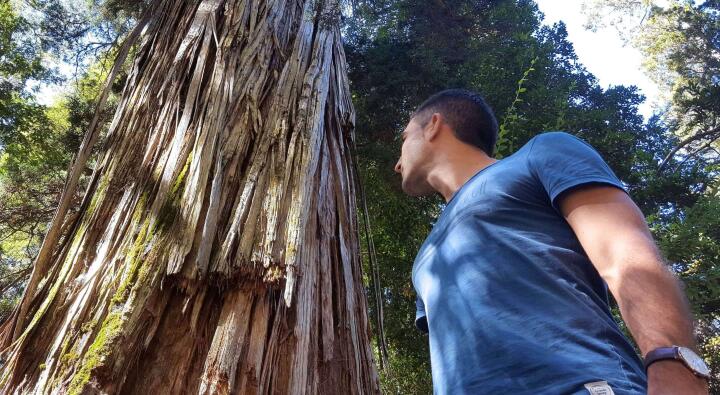
Patagonian has wine, bien sûr!
Argentinian Malbec from Mendoza and Chilean Cabernet Sauvignon from the Maipo province may dominate all the headlines, but Patagonia also has its own less talked about a range of thriving wineries. The Patagonian weather of intense winters and summer cool nights is prime condition for certain grapes, particularly Pinot Noir.
We visited the Viñas de Nant y Fall winery near Esquel, Argentina, a gay-owned vineyard specializing in Pinot Noir grapes, which prides itself on being “the southernmost vineyard in the world”!
If you come in March, you may catch some of the local Vendimia (grape harvesting) festivities along with lots of wine tasting. LGBTQ travelers visiting during this period will also want to check out the gay segment of the grape harvest festival in Mendoza called Vendimia Para Todos.
Welsh people live here!
Patagonia is home to one of the largest Welsh communities outside of Wales, especially in the Chubut region of Argentina. Settlers first arrived in 1865 in Puerto Madryn and over the years spread inland, creating settlements like Gaiman, Trelew, Trevelin and Dolavon.
The Welsh culture has been retained across the region. For example, you can find road signs in Welsh as well as family-owned tea houses serving elaborate Welsh tea.
We sought out several teahouses for Welsh tea including Nain Maggie in Trevelin and Ty Té Caerdydd in Gaiman where queer icon Princess Diana famously had tea in 1996. We spent the afternoon gay gossiping, whilst drinking tea and eating some delicious treats. Welsh tea features a variety of cakes and tarts, including the renowned torta negra (Welsh cake) made using recipes handed down by previous generations.

Mummy whales come here to give birth
One of our favourite fun facts about Patagonia: the East coast of Patagonia is a popular breeding ground for whales. They reproduce every 2-3 years, opting for the safe and quiet waters around Peninsula Valdés in Chubut.
One of the best places to see them is in Puerto Madryn or by boat trip from Puerto Piramedes, between May to December, when they come right up to the shore to give birth and raise their calves.
This area is also famous for having a lot of wildlife like penguins, seals, sea lions, and orcas.
The biggest dinosaur ever is from Patagonia
Dino fans will love this fun fact about Patagonia: the fossils of the largest ever dinosaur that walked our planet was found smack bang in the middle of Patagonia on the Argentinian side.
This dinosaur is still unnamed but is known to have been a herbivore, measuring 42m in length and weighing 76 tons. To get an idea of its size, a statue of what it would have looked like has been recreated just outside of Trelew so you can visit and pretend you're in Jurassic Park.
There is also a fascinating dinosaur museum in Trelew worth visiting, dedicated to all the dinosaur fossils found in the region, along with a laboratory where you can see the paleontologists at work.
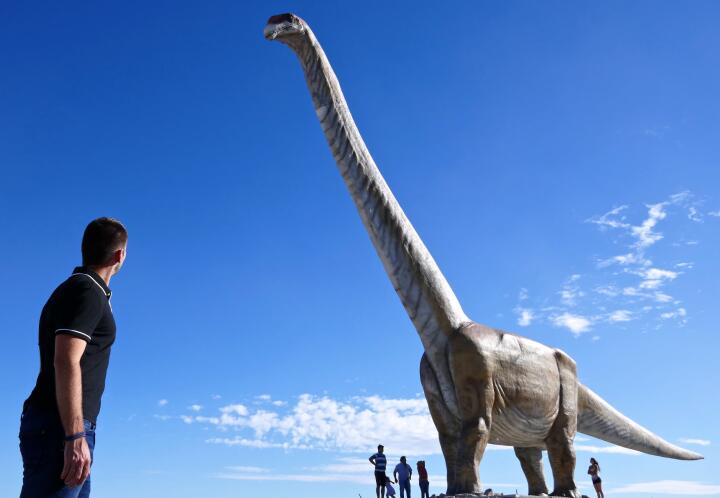
El Calafate is not just a city, it's also a fruit
El Calafate is the main city hub for tours to the famous Perito Moreno and surrounding glaciers. However, its name emanates from the Patagonian plant of the same name, which grows in abundance in the area.
The calafate produces a berry-like fruit, which you can use to make marmalades, liquors, teas, ice creams, soups and even vodka.
On the Chilean side of Patagonia, look out for yummy purple looking Calafate Pisco Sour, but go easy on these, they're not for the faint-hearted!
Patagonia is a desert!
That's right. The 8th largest in the world in fact. The Patagonian desert is 673,000 square kilometres (260,000 mi2) and is primarily located in Argentina. It spreads all the way from the Andes on the Argentinian side to the Atlantic Ocean.
The Patagonian desert is a cold winter desert, with average temperatures of only 3 degrees Celsius (37 Fahrenheit), rarely exceeding 12 degrees celsius (53 Fahrenheit).
Whilst you may associate the desert with sand dunes, it is in fact a barren area of land, with little precipitation and hostile conditions for plant and animal life. Therefore, the largest desert on our planet is Maudlandia in Antarctica, followed by the Arctic and Sahara deserts.
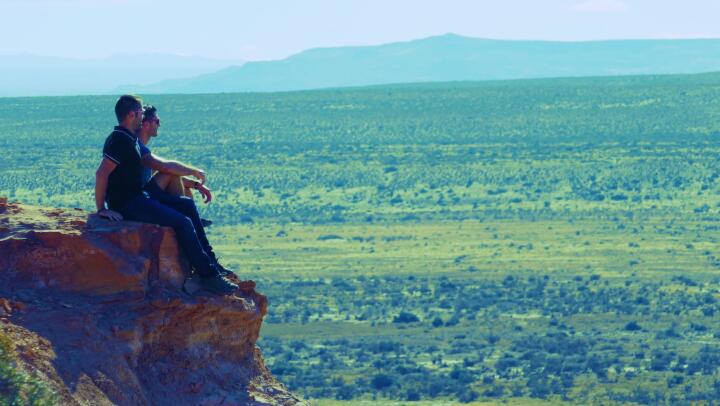
It has a growing, expanding glacier
The Perito Moreno glacier is a popular landmark in Patagonia, located in the Argentinian Los Glaciares National Park, a UNESCO World Heritage site.
From all our interesting facts about Patagonia, this one is unique and rare because, unlike most glaciers in the world, Perito Moreno is growing in size instead of receding. The precise scientific reasons why glaciers like Perito Moreno are receding are not yet fully understood by glaciologists.
Perito Moreno is also very accessible. We fulfilled our Elsa fantasy and hiked across Perito Moreno as part of a tour wearing crampons. Walking on the ice of this giant glacier is an experience we'll never forget and one we truly recommend to travelers visiting Patagonia.
Largest colony of Magellanic Penguins in the world
As a gay couple, we love penguins. You must have heard about Ronnie and Reggie, the famous gay penguin couple of London Zoo as well as Skipper and Ping of Berlin Zoo? Well, Argentina has a large colony of penguins, so we jumped at the chance of seeing them in the wild!
One of the largest colonies of Magellanic penguins can be found at Punta Tombo, on the Argentinian side by the coast. Over 1 million Magellanic penguins descend on the region between mid-September to mid-April to nest, breed, moult and then migrate to the warmer climates in South Brazil. They are named after Ferdinand Magellan, who discovered them when he arrived in South America in 1520.
The Magellanic penguins grow to around 61-76 cm (24-30 inches) and are extremely cute to watch, especially when they're clumsily waddling around on land.
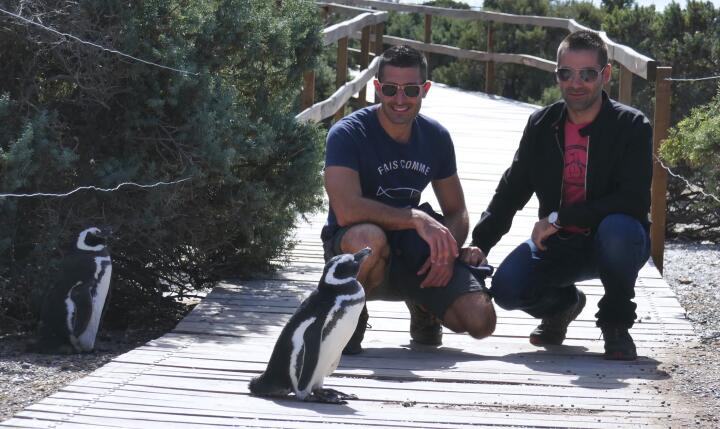
Read more travel adventures like this in our book!
We've published our very own gay travel book called, ‘Out in the World'. It has all our practical safety tips, first-hand advice, and travel stories from some of our favorite destinations.
We hope it inspires you to have a fun and safe trip!
Click on the book to order:

For more inspiration:
- Make sure you also check out our favorite highlights of visiting Patagonia
- These are also some of the best gay hotels in Patagonia to stay in
- Read our full gay guide to Puerto Madryn
- Here's our gay country guide to Argentina
- As well as a gay city guide for Buenos Aires
- And don't miss out on these unique gay hotels in Buenos Aires while you're there
- If you're traveling as a couple check out our favorite romantic things to do in Buenos Aires too
- Make sure you also read these interesting facts about Chile
Like this post? Pin it
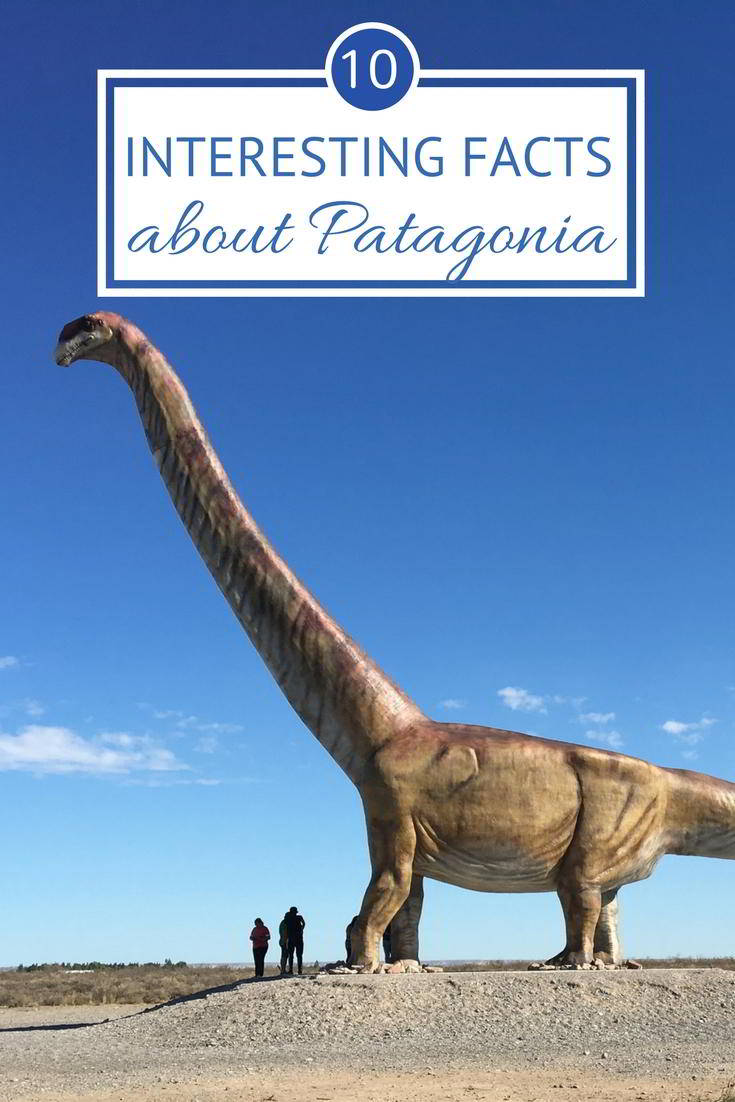
Happy travels are safe travels
We recommend you always take out a reputable travel insurance before your next vacation. What happens if you suffer from illness, injury, theft, or a cancellation? Many travelers forget about it and regret it when something happens. Better to pay a small price and have the peace of mind and not worry.


Hakan Duzenli
Friday 20th of September 2019
Hey boys ❤❤❤❤
Stefan Arestis
Friday 20th of September 2019
Hi buddy how are you?
Leo kohler
Friday 20th of September 2019
Hey❤️❤️❤️❤️❤️❤️
Ryan Biddulph
Tuesday 11th of July 2017
The size and scale of that dinosaur is beyond stunning guys. That many tons and that long; like a real world Jurassic Park indeed. I do recall Patagonia is a fossil hot spot, being so unexplored in many ways. Not much disturbance so all the dino bones are begging to be dug out.
Nomadic boys
Tuesday 11th of July 2017
Very true!